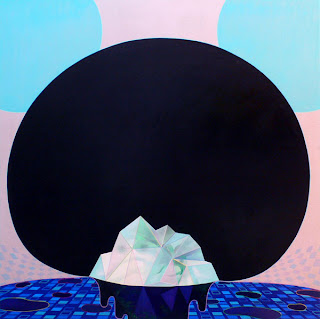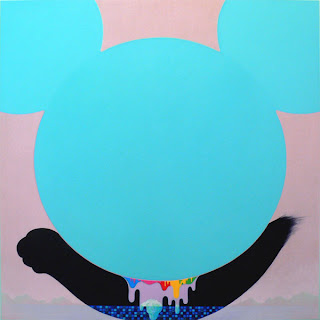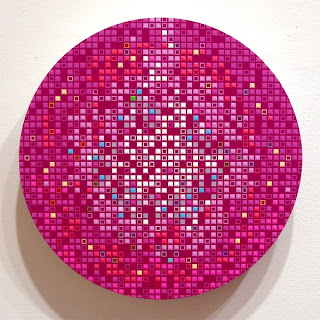Hidenori Ishii is a young MICA graduate with a Solo Exhibition at the Grimaldis Gallery until February 28. I recently caught up with him and we had a conversation about his new body of work, his career, and the idea of ‘earthshine.’
 Cara: Where are you from originally? How does this affect your paintings?
Cara: Where are you from originally? How does this affect your paintings?
Hidenori: I was born and raised in Japan up until I moved to the US when I was eighteen for my college education. At first, I came to the college to study environmental science not fine art, but somehow made the transition within a few years of staying here. My concern towards the environmental subject is more obvious in my work now, but I studied more academic/ traditional approach to painting when I was in college.
When I was growing up in the suburb where I had many interaction with nature, I was surrounded by video games in 80’s and favored animations such as Miyazaki Films and Akira, like other kids. Miyazaki films often have environmental messages. So I think my concern towards the environment in nature grew from both the actual contact and fantasy.?I wouldn’t say I was influenced by animation in general directly, but could say the graphic aspect of those video games and how you play and roll in the two dimensional surface created by pixilation, relates to my interest in Neo-Geo a bit. Anyway, I think aesthetically my work has some reference to them, and of course the cultural context affected my personality.
Cara: Where do you live and work? You got your MFA from MICA, correct?
Hidenori: I actually live in Long Island City, Queens in New York and that’s where I have my studio space too. Yes, I got the MFA from MICA in 2004.
 Cara: I was told that you apprenticed in the studio of Takashi Murakami for several years? Is this true? What was this like for you? Where were you? What did you learn from the experience?
Cara: I was told that you apprenticed in the studio of Takashi Murakami for several years? Is this true? What was this like for you? Where were you? What did you learn from the experience?
Hidenori: Yes, I had worked for Murakami for several years in his Brooklyn (later Long Island City) studio. Overall, it was interesting in many ways, although it was hellish because I worked so much back then… But, I learned many things out of the experience. Of course they include the technical aspects and productivity of work, professionalism and drive as an artist, and a sort of business aspect of his company, Kaikai Kiki.
Anyway, it seems more interesting to me that this artist who knows how to make good paintings (I know this is very subjective term, but you know what I mean) is more driven by the larger game/picture over what his actual work are all about as his respond to the art world. I would say he’s a very intellectual man when it comes to art making and theory.
Cara: Your current show at C. Grimaldis Gallery is titled “A Little Earthshine.” Where did the title come from and how does it relate to the work?
Hidenori: The show title, “A Little Earthshine”, came from the phenomena, earthshine. According to Wikipedia, Earthshine is reflected Earthlight visible on the Moon’s night side. (http://en.wikipedia.org/wiki/Earthshine ) As I had worked on the paintings in the show all together spontaneously, I think each of them has clues and traces of time for the other paintings in the group of the show. In other words, I’m more interested in activating whole group of paintings as the device of narration rather than each tells different individual scenes or stories.
Hidenori: So let’s say, if the audience is the earth in the triangle relation of the sun, earth and moon, the audience is looking at Painting A (the moon) on the side of Painting B (the sun) in the back of head. While the earth (audience) is viewing the moon (Painting A), the earth (audience) sees glimpse of earthlight on the moon (painting A), which is actually coming from the sun (Painting B).
I wanted to have that sort of relational effect on the viewers in the exhibition when they walk in, having Painting B (the sun) glow on the viewers subconsciously while they are engaged with Painting A (the moon)… if this makes sense to you. So, this show was my first attempt to actually work things out with the idea in my mind, and that’s why it’s called “A Little Earthshine.”
Also, whatever events or scenes in my work are happening on the earth, although some of them may seem to look outer space. And they are sort of hope or possibility for this new environmental/ecological system and I want them to grow on the earth, so I thought literally earth-shine is good for the show.
Cara: From a first viewing, your paintings are impeccably crafted and employ several contrasting devices for creating an artificial sense of space and time, almost to a futuristic effect. Which do you focus on more in your studio: the physical act of painting or the content/message? Or both?
Hidenori: I’m not smart enough to have the image ready in 100% or closer to that when I actually start painting. So first, I always develop ideas and dialogues in my work as more of writings in the sketch book first, and then it’s all about executing and figuring out what needs to be done next in/on the actual paintings. I also take the image from the photos of work in progress and actually draw on them, too. So, I think both.
Cara: The paintings are on canvas, but the surfaces have no trace of the texture of canvas. They look like glass. How do you prepare your canvasses before you paint on them?
Hidenori: There is actually no secret for this. It just requires a lot of priming and sanding. But I do take a good care of canvas, showing the subtle linen surface using PVA sizing and acrylic medium.
 Cara: Who are your favorite contemporary artists?
Cara: Who are your favorite contemporary artists?
Hidenori: I guess I have many, so I’d rather say one painter, Nigel Cooke.
Cara: Where have you exhibited your work in the past and where would you like to exhibit your work?
Hidenori: In last few years, I’ve only exhibited at Grimaldis gallery, so I haven’t really exhibited as much yet. At this point, I really want more numbers of people to actually see my work and it’s important, so I’d love to show my work in the larger cities. I live here in NY, so that’s one of them, I think.
Cara: What are your plans, projects, and goals for the future?
Hidenori: Currently, I don’t have any solid plan for upcoming show yet except for a few probable shows. But I’m exited to explore what would come out for the next group of work since my painting actually takes a long time. I’d love to have an opportunity to show in some sort of space program in institutions or museums someday.
 Cara: What piece of advice do you think is best to tell young artists? Is there anything you wish you had known when you started out in your art career?
Cara: What piece of advice do you think is best to tell young artists? Is there anything you wish you had known when you started out in your art career?
Hidenori: I actually just started my career so I don’t know if this means a lot to them, but I really believe this is a long game, I mean the life long game. So, I think it’s more important to be patient with what you do.
 Artist Statement by Hidenori Ishii:
Artist Statement by Hidenori Ishii:
My work suggests integrated psychological and environmental systems that allude to a self-contained biosphere built on a lifetime of collected idiosyncrasies. Following constellations reminiscent of the realization and submerged mind, I rigidly depict the structure of fantasy.
I believe painting is where actuality and possibility meet with one’s intention. As a landfill utilizes the progresses of nature of a long period of time, I’m interested in visual and symbolic dialogue of between man’s intention and nature’s inevitabilities. Using combination of patterns both from nature and man-made, my paintings suggest transformations, erosions and constructions of improbable environments. Through its evident execution, my work creates a space where submerged human or natural potentials are rendered visible over time.
This created space, based on a disconnected experience of landscape, operates as an environment where I can search clarification of self and psychological articulation in the face of an ambiguous cultural identity.
 12 a.m.
12 a.m.
For more information about the show or the artist, go to the Grimaldis Gallery website.









